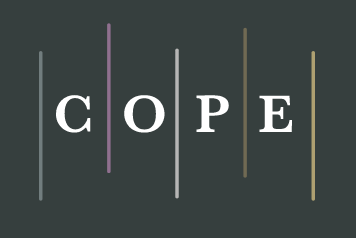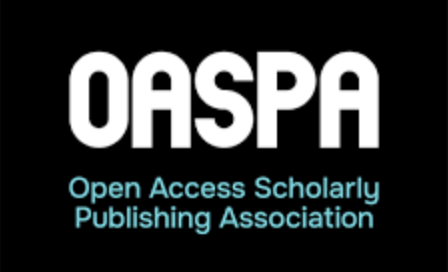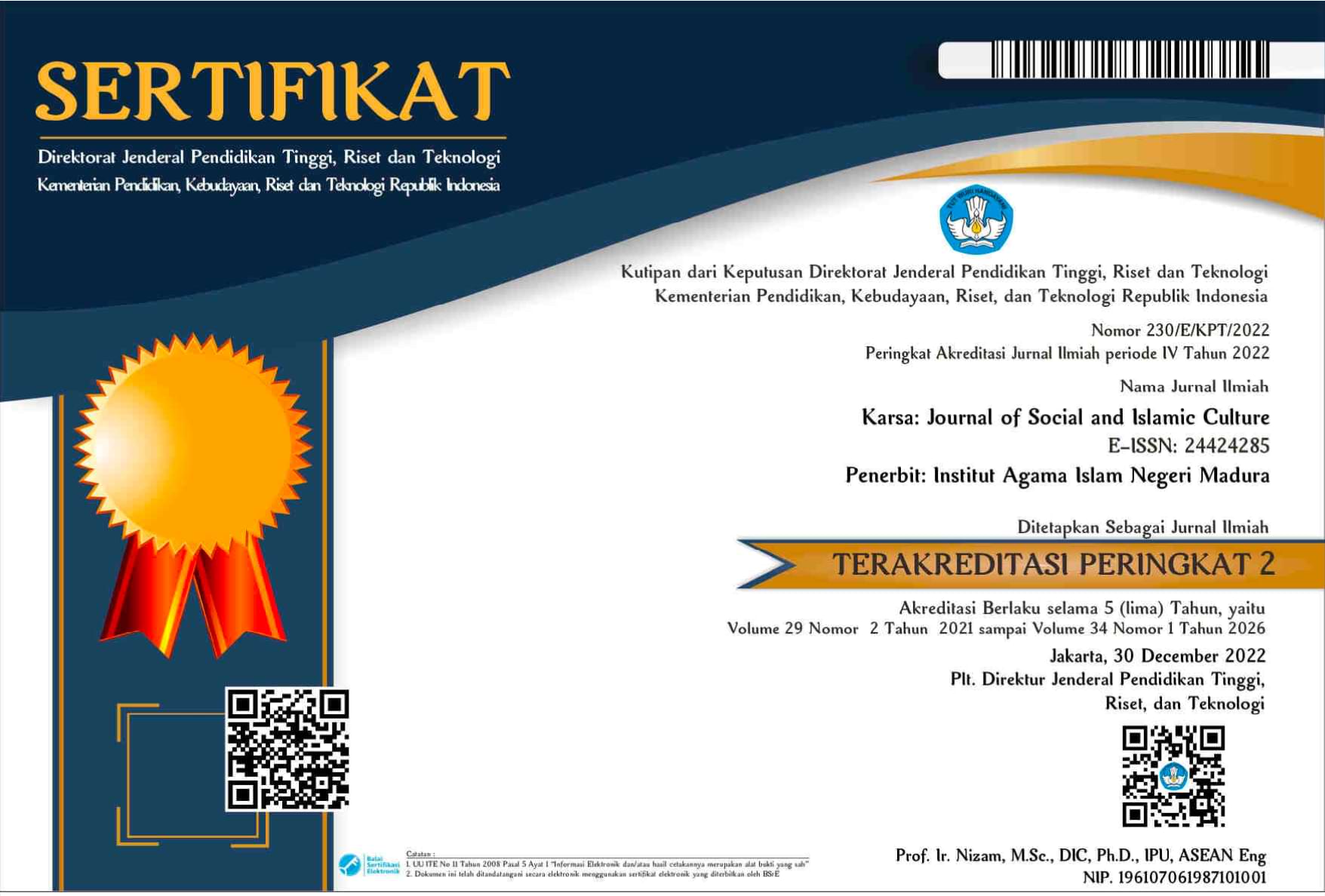Nature Symbols and Symbolism in Sufic Poems of Ibn Arabi
 Abstract views: 626
,
Abstract views: 626
,
 PDF downloads: 435
PDF downloads: 435
Abstract
Ibn Arabi is regarded as a pioneer of wahdat al-wujud concept seeing that all creatures unite with the essence of God. Ibn Arabi frequently depicts his concepts and thoughts on Sufism through poetries that contain nature symbols. It raises questions in this study: what symbols are in Ibn Arabi’s poetries? What do these symbols mean? Is there a correlation between nature symbols in his poetries with his concept of wahdat al-wujud? To answer those three questions, the author uses qualitative methodology by using a number of both primary and secondary resources for library research. To analyze the symbols, Arabic rhetoric science-based approach is used, especially bayan. The study finds that certain symbols have been used by Ibn Arabi as such sun, moon, star, earth and sky. Ibn Arabi uses the symbols of sun to represent God as the main source of universe, of moon to represent God’s tajalli in His creatures, of sky for the highest attribute of God, of earth for human’s contemptible nature, and of stars bridging the sky and earth representing spirit blown by God onto human. Hence, nature symbols themselves disprove the concept of wahdat al-wujud that has been proposed by scholars so far.
Copyright (c) 2017 by KARSA. All right reserved
Downloads
References
’Amr, Syihabuddin Abu. Mu’jam Al-Maqayis Fi Al-Lughah Li Abial-Husain Ahmad Ibnu Faris Ibu Zakariyya. Beirut: Dar al-Fikr, 1994.
Ahmad, Muhammad Futuh. Al-Ramz Wa Al-Ramziyyah Fi Al-Syi’r Al-Mu’ashir. Kairo: Dar al-Ma’arif, 1978.
Al-’Ajam, Rafiq. Mausu’at Mustalah Al-Tasawuf Al-Islami. Beirut: Maktabah Lubnan Nasyirun, 1999.
Al-Faruqi, Ismail R. Atlas Budaya: Menjelajah Khazanah Peradaban Gemilang. Bandung: Mizan, n.d.
Al-Hafni, Abdu al-Mun’im. Mu’jam Al-Mustalahat Al-Sufiyah. Beirut: Dar al-Masirah, 1987.
Al-Hakim, Su’ad. Al-Mu’jam Al-Shufi, Al-Hikmah Fi Judur Al-Kalimat. Beirut: Dandarah, 1981.
Al-Hasyimi, Ahmad. Jawahir Al-Balaghah Fi Al-Ma’ani Wa Al-Bayan Wa Al-Badi’. Maktabah Dar al-Kutub al-’Arabiyah, 1960.
Al-Jarim, Ali. Al-Balaghah Al-Wadhihah. Jakarta: Raudhah Faris, 2007.
Al-Jilli, Ibrahim. Al-Insan Al-Kamil. Beirut: Dar al-Kutub al-Ilmiyah, 1997.
Al-Kiyyali, ’Ashim Ibrahim. Fusus Al-Hikam. Beirut: Dar al-Kutub al-Ilmiyah, 2003.
Al-Tunji, Muhammad. Al-Mu’jam Al-Mufassal Fi Al-Adab. Beirut: Dar al-Kutub al-Ilmiyah, 1993.
Atmazaki. Ilmu Sastra: Teori Dan Terapan. Padang: Angkasa Raya, 1990.
Basaj, Ahmad Hasan. Diwan Ibnu Arabi. Beirut: Dar al-Kutub al-Ilmiyah, 1996.
Braginsky. Yang Indah, Berfaedah Dan Kamal: Sejarah Sastra Melayu Dalam Abad 7-19. Jakarta: INIS, 1998.
Endraswara, Suwardi. Metodologi Penelitian Sastra. Yogyakarta: Pustaka Widyatama, 2004.
Fuadi, Muhammad Robith. “Memahami Tasawuf Ibnu Arabi Dan Ibnu Al-Farid: Konsep Al-Hubb Illahi, Wahdat Al-Wujud, Wahdah Al-Syuhud Dan Wahdat Al-Adyan.” Ulul Ablal Islamic Studies Journal 14, no. 2 (2013).
Khafaji, Muhammad Abd al-Mun’im. Al-Adab Fi Turats Al-Shufi. Maktabah Gharib, n.d.
Khuzam, Anwar F Abi. Mu’jam Al-Mustalahat Al-Sufiyyah, 1993.
“Konsep Insan Kamil Ibn Arabi,” n.d. http://pengkajianpelitahati.wordpress.com/2011/04/25/konsep-insan-kamil-ibn-arabi/.
Ma’luf, Louis. Al-Munjid, n.d.
Manzur, Ibnu. Lisan Al-Arab. Beirut: Dar al-Fikr, n.d.
Munawwir, Ahmad Warson. Al-Munawwir Arabic-Indonesian Dictionary. Yogyakarta: Pustaka Progressif, 1997.
Nawaf Al-Jarrah. Al-Futuhat Al-Makkiyah Li Al-Syaikh Al-Akbar Muhyidin Ibnu ’Arabi. Beirut: Dar al-Shadir, 2004.
Nilyati. “Konsep Dasar Pemikiran Filosofis Ibnu Arabi.” Tajdid 11, no. 2 (2012).
Rahmat, Pupu Saeful. “Penelitian Kualitatif.” Equilibrium 5, no. 9 (2009): 1–9.
Salim, Peter. Kamus Bahasa Indonesdia Kontemporer, n.d.
Tim Penulis UIN Syarif HIdayatullah Jakarta. Ensiklopedi Tasawuf. Bandung: Angkasa, 2008.
Tim Penyusun. Kamus Besar Bahasa Indonesia. Balai Pustaka, 2007.
Zoest, Aart Van. Semiotika: Tentang Tanda, Cara Kerjanya dan Apa Yang Kita Lakukan Dengannya. Jakarta: Yayasan Sumber Agung, 1993.
The journal operates an Open Access policy under a Creative Commons Non-Commercial Share-Alike license. Authors who publish with this journal agree to the following terms:
- Authors retain copyright and grant the journal right of first publication with the work simultaneously licensed under a Creative Commons Attribution License that allows others to share the work with an acknowledgement of the work's authorship and initial publication in this journal.
- Authors are able to enter into separate, additional contractual arrangements for the non-exclusive distribution of the journal's published version of the work (e.g., post it to an institutional repository or publish it in a book), with an acknowledgement of its initial publication in this journal.
- Authors are permitted and encouraged to post their work online (e.g., in institutional repositories or on their website) prior to and during the submission process, as it can lead to productive exchanges, as well as earlier and greater citation of published work.



















